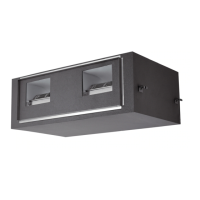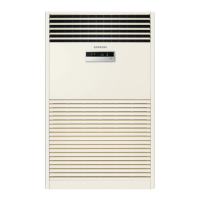16_ installing your air conditioner
Installation Part
Indoor Unit Installation
It is recommended to install the Y-joint before installing
the indoor unit.
1.
Place the pattern sheet on the ceiling at the spot
where you want to install the indoor unit.
Since the diagram is made of paper, it may
shrink or stretch slightly due to temperature
or humidity. For this reason, before drilling
the holes maintain the correct dimensions
between the markings.
Note
2.
Insert bolt anchors, use existing ceiling supports or
construct a suitable support as shown in figure.
Concrete
Suspension bolt(Φ9.52 or M10)
Hole in anchor
Hole in plug
Insert
3.
Install the suspension bolts depending on the ceiling type.
X
Ensure that the ceiling is strong enough
to support the weight of the indoor unit.
Before hanging the unit, test the strength
of each attached suspension bolt.
X
If the length of suspension bolt is more than
1.5m, it is required to prevent vibration.
X If this is not possible, create an opening on
the false ceiling in order to be able to use it
to perform the required operations on the
indoor unit.
CAUTION
Ceiling support
4.
Screw eight nuts to the suspension bolts making
space for hanging the indoor unit.
You must install the suspension bolts more
than four when installing the indoor unit.
CAUTION
Rubber
5.
Hang the indoor unit to the suspension bolts between
two nuts.
Piping must be laid and connected inside
the ceiling when suspending the unit. If the
ceiling is already constructed, lay the piping
into position for connection to the unit before
placing the unit inside the ceiling.
Note
6.
Screw the nuts to suspend the unit.
7.
Adjust level of the unit by using measurement plate for all 4 sides.
For proper drainage of condensate, give a 1°
slant to the left or right side of the unit which
will be connected with the drain hose, as
shown in the figure. Make a tilt when you wish
to install the drain pump, too.
Note
Drain hose port
1°
Performing Leak Test & Insulation
Leak test
LEAK TEST WITH NITROGEN(before opening valves)
In order to detect basic refrigerant leaks, before recreating
the vacuum and recirculating the R-410A, it’s responsible of
installer to pressurize the whole system with nitrogen(using
a pressure regulator) at a pressure above 4.1MPa(gauge).
LEAK TEST WITH R-410A(after opening valves)
Before opening valves, discharge all the nitrogen into the
system and create vacuum. After opening valves check
leaks using a leak detector for refrigerant R-410A.
Leak check
Discharge all the nitrogen to create a vacuum and
charge the system.
CAUTION
Insulation
Once you have checked that there are no leaks in the sys-
tem, you can insulate the piping and hose.
1.
To avoid condensation problems, place T13.0 or thicker
Acrylonitrile Butadien Rubber separately around each
refrigerant pipe.
Always make the seam of pipes face upwards.
Note
No gap
NBR(T13.0 or thicker)

